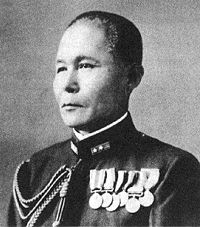- Jisaburō Ozawa
-
Jisaburō Ozawa
Japanese Admiral Jisaburō OzawaNickname "Gargoyle" Born October 2, 1886
Koyu District, Miyazaki, JapanDied November 9, 1966 (aged 80)[1] Allegiance  Empire of Japan
Empire of JapanService/branch  Imperial Japanese Navy
Imperial Japanese NavyYears of service 1909-1945 Rank Vice Admiral Commands held World War II
--Battle of the Philippine Sea
--Battle of Leyte GulfAwards Order of the Sacred Treasure (2nd class) Vice-Admiral Jisaburō Ozawa (小澤 治三郎 Ozawa Jisaburō, 2 October 1886 – 9 November 1966) was an admiral in the Imperial Japanese Navy during World War II. He was the last Commander-in-Chief of Combined Fleet.[3] Many military historians regard Ozawa as one of the most capable Japanese flag officers.
Contents
Biography
Ozawa was born in rural Koyu County, Miyazaki prefecture on the island of Kyūshū, Japan.
Ozawa graduated from the 37th class Imperial Japanese Naval Academy in 1909, placing 45th in a class of 179 cadets. He performed his midshipman service on the cruisers Soya and Kasuga and battleship Mikasa.
As an ensign, Ozawa served on the destroyer Arare, battleship Hiei and cruiser Chitose, and as a lieutenant, on Kawachi and torpedo warfare in his studies, and after his graduation from the Naval War College (Japan) in 1919 and promotion to lieutenant commander, he was given his first command, the destroyer United States and Europe. On 15 November 1934, he was assigned command of the Maya and Haruna the following year.
On 1 December 1936, Ozawa was promoted to rear admiral.[2] He continued to serve in various staff positions, including Chief of Staff of the Combined Fleet in 1937 and Commandant of the Imperial Japanese Naval Academy. He was promoted to vice admiral on 15 November 1940.
Ozawa was one of leading advocates of naval aviation in the Imperial Japanese Navy. Ozawa was the first high-ranking officer to recommend that the Japanese aircraft carrier forces be organized into an air fleet so that they could train and fight together.
After the attack on Pearl Harbor, Ozawa became responsible for Japan's naval operations in the South China Sea as Commander in Chief of the Southern Expeditionary Fleet covering the invasion of Malaya. In early 1942 (January to March), his fleet was involved in the invasions of Java and Sumatra.[4]
In March–April 1942 he commanded the highly successful commerce raiding detachment during the foray into the Indian Ocean.[4]
On 11 November 1942, Ozawa was appointed Commander in Chief of the IJN 3rd Fleet,[2] relieving Admiral Chūichi Nagumo as commander of Japan's carrier forces. Ozawa proved an aggressive and skilled commander, but was overwhelmed by the numerical and technological superiority of the United States at the Battle of the Philippine Sea. After the battle, Ozawa retreated to Okinawa where he tendered his resignation — which was not accepted.
What was left of Ozawa's fleet fought on at the Battle of Leyte Gulf[4] against the forces of Admiral William Halsey. Although he was the senior admiral at the Battle of Leyte Gulf, Ozawa was not given a leading command position since the Japanese battle plan was to sacrifice his force as a decoy so Admiral Takeo Kurita's Center Force could traverse San Bernardino Strait and freely fall upon MacArthur's invasion forces on the Leyte beaches. Nevertheless, Ozawa played his role intelligently and professionally until the end, although his fleet ended its combat career off of the Philippines as little more than a bait force, flight decks empty for lack of planes and pilots.
On 1945 May 29 he accepted a position on the Imperial Japanese Navy General Staff,[2] and was the final CINC of the Imperial Japanese Navy from 29 May 1945.[4] He refused promotion to full admiral, and remained as vice admiral until the final dissolution of the Imperial Japanese Navy.
Ozawa, nicknamed 'The Gargoyle' (Onigawara) by his men, was extremely tall (6'7", 2 m) and was commonly regarded as one of the three ugliest admirals in the Navy. He also had a reputation of being both courageous and compassionate towards his men.[3]
Ozawa died in 1966 at the age of 80.
Notes
- ^ Nishida, Imperial Japanese Navy
- ^ a b c d e "Ozawa Jisaburo". Naval History via Flix. http://navalhistory.flixco.info/H/171240x19846/8330/a0.htm.
- ^ a b Parshall, Jonathan. "Jisaburo Ozawa". Combinedfleet.com. http://combinedfleet.com/officers/Jisaburo_Ozawa.
- ^ a b c d Klemen, L (1999-2000). "Vice-Admiral Jisaburo Ozawa". Forgotten Campaign: The Dutch East Indies Campaign 1941-1942. http://www.dutcheastindies.webs.com/ozawa.html.
References
Books
- Costello, Frank (2001). The Second World War. Harper Perennial. ISBN 0688016200.
- D'Albas, Andrieu (1965). Death of a Navy: Japanese Naval Action in World War II. Devin-Adair Pub. ISBN 0-8159-5302-X.
- Dull, Paul S. (1978). A Battle History of the Imperial Japanese Navy, 1941-1945. Naval Institute Press. ISBN 0-87021-097-1.
- Field, James A. (1947). The Japanese at Leyte Gulf;: The Sho operation. Princeton University Press. ASIN B0006AR6LA.
- Frank, Richard (2001). Downfall: The End of the Imperial Japanese Empire. Penguin. ISBN 0141001461.
- Gilbert, Martin (2004). The Second World War: A Complete History. Holt. ISBN 0805076239.
- Keegan, John (2005). The Second World War. Penguin. ISBN 0143035738.
- Sheftall, M.G. (2005). Blossoms in the Wind: Human Legacies of the Kamikaze. NAL Caliber. ISBN 0451214870.
- Spector, Ronald (1985). Eagle Against the Sun: The American War With Japan. Vintage. ISBN 0394741013.
External links
- Nishida, Hiroshi. "Ozawa, Jisaburo". Imperial Japanese Navy. http://homepage2.nifty.com/nishidah/e/px37.htm#v006. Retrieved 2006-06-14.
- "Ozawa, Jisaburo". The Pacific War Online Encyclopedia. http://pwencycl.kgbudge.com/index.htm. Retrieved 2006-06-14.
- Friedmann, Kenneth. "Ozawa, Jisaburo". Battle of Leyte Gulf. http://www.battle-of-leyte-gulf.com/Leaders/Japanese/Ozawa/ozawa.html. Retrieved 2006-06-14.
- "Ozawa, Jisaburo". Combined Fleet.com. http://www.combinedfleet.com/officer.htm. Retrieved 2006-06-14.
 Categories:
Categories:- 1886 births
- 1966 deaths
- Imperial Japanese Navy admirals
- Japanese military personnel of World War II
- People from Miyazaki Prefecture
Wikimedia Foundation. 2010.



